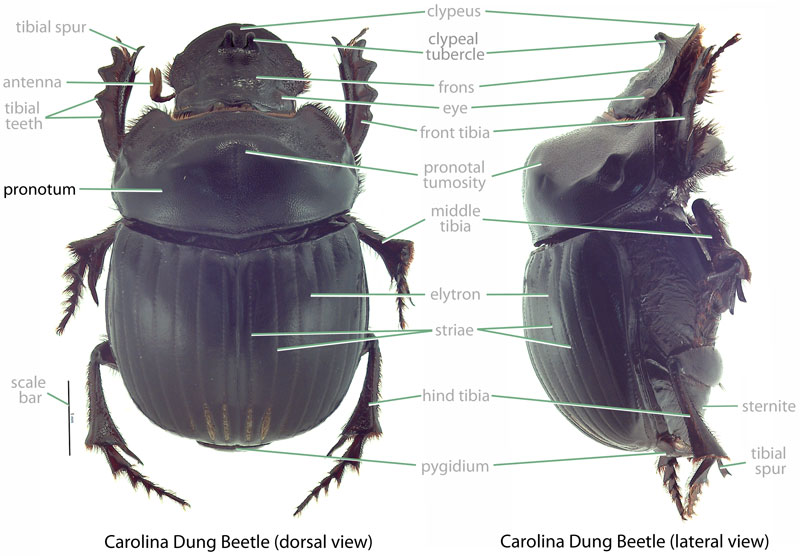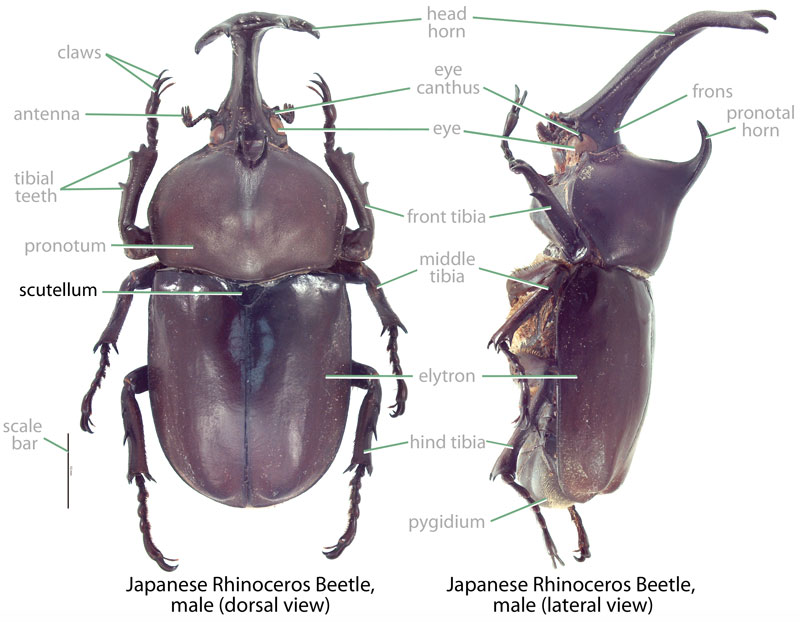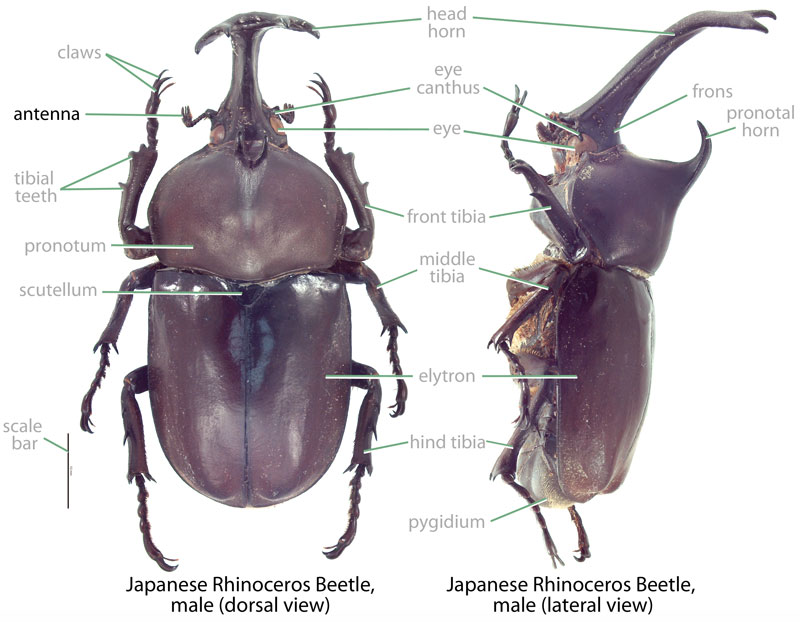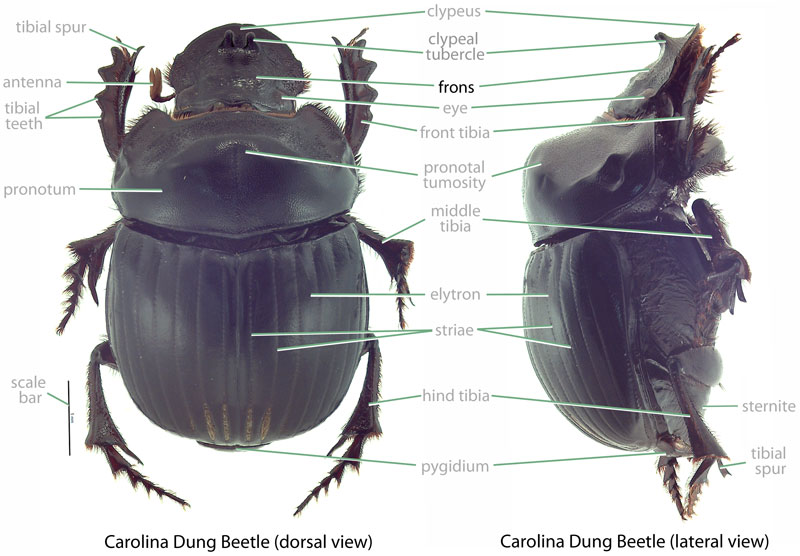Native
none known
Family: Scarabaeidae Subfamily: Melolonthinae Genus: Lepidiota Species: Lepidiota carolinensis Arrow, 1939
none available
Total body length 19.0–21.9 mm (0.74–0.86 in). Body shape oblong, cylindrical, tapering slightly posteriorly. Color yellowish-brown; head, pronotumpronotum:
the dorsal surface of the thorax
 , and scutellumscutellum:
, and scutellumscutellum:
the triangular portion of the thorax between the bases of the elytra
 brownish-red. AntennaeAntennae:
brownish-red. AntennaeAntennae:
paired sensory organ on head, formed from numerous segments
 10-segmented; club 3-segmented; club subequal in length to scapescape:
10-segmented; club 3-segmented; club subequal in length to scapescape:
basal (first) segment of the antennae
(male) or half the length of scapescape:
basal (first) segment of the antennae
(female). ElytraElytra:
the hardened and chitinous wing-cover of a beetle that protect and overlie the flight wing
with numerous small white scales; weakly striated.
Undescribed. For Lepidiota (Ahrens et al., 2007Ahrens et al., 2007:
Ahrens D, Zorn C, Dhoj Y, Keller S, Nagel P. 2007. Illustrated key to phytophagous scarabs of Nepal (Coleoptera, Scarabaeidae). Opuscula Biogeographica Baseleensia 5: 1-44.): Grub C-shaped, not hump-backed, cylindrical, whitish. Galeagalea:
outer branch or lobe of the maxilla
 and lacinialacinia:
and lacinialacinia:
inner portion of the maxilla fused proximally but separated distallydistally:
fused proximally but separated distallydistally:
situated away from the point of articulation, thus usually furthest from the body
or tightly fitted together. Fronsfrons:
part of the head generally positioned between the eyes (posterior to the clypeus and anterior to the vertex) and visible dorsally
 rugose. Claws of hind legs reduced. Rasterraster:
rugose. Claws of hind legs reduced. Rasterraster:
in scarab larvae, a complex of setose, spiny, and bare areas on the ventral surface of the last abdominal segment with 2 parallel rows of setaesetae:
with 2 parallel rows of setaesetae:
small, hair-like structure
. Anal opening Y-shaped.
Western Micronesia. This species is endemicendemic:
in biogeography, a species that occurs only in a given location
to the Marianas (including Guam) and Palau (Cartwright and Gordon, 1971Cartwright and Gordon, 1971:
Cartwright O and Gordon R. 1971. Insects of Micronesia Coleoptera: Scarabaeidae. Insects of Micronesia 17: 256-296.).
Not recorded. In many related Lepidiota species, adults are generalist folivores and larvaelarvae:
the immature form of an insect; in scarabs, also called grub or white grub; preceded by the egg stage, followed by the pupal stage
 feed upon grass roots (Kuniata and Young, 1992Kuniata and Young, 1992:
feed upon grass roots (Kuniata and Young, 1992Kuniata and Young, 1992:
Kuniata L and Young G. 1992. The biology of Lepidiota reuleauxi Brenske (Coleoptera: Scarabaeidae), a pest of sugarcane in Papua New Guinea. Journal of the Australian Entomological Society 31: 339-343.).
Poorly known. Cartwright and Gordon (1971) noted that this species comes to lights, suggesting nocturnal habits. It is likely that adults are folivores and that the larvaelarvae:
the immature form of an insect; in scarabs, also called grub or white grub; preceded by the egg stage, followed by the pupal stage
 develop within soil where they feed on grass roots. Such habits are seen in related Lepidiota species (Kuniata and Young, 1992Kuniata and Young, 1992:
develop within soil where they feed on grass roots. Such habits are seen in related Lepidiota species (Kuniata and Young, 1992Kuniata and Young, 1992:
Kuniata L and Young G. 1992. The biology of Lepidiota reuleauxi Brenske (Coleoptera: Scarabaeidae), a pest of sugarcane in Papua New Guinea. Journal of the Australian Entomological Society 31: 339-343.). There are likely one or two generations per year.
Probably none. There are no records of this poorly known species feeding on commercially important plants. However, a considerable number of related species are significant larval pests of grasses including (but not limited to) Lepidiota frenchi, L. squamulata, and L. stigma (all of which all feed on sugarcane) (Britton, 1962Britton, 1962:
Britton E. 1962. A new species of Lepidiota (Coleoptera: Melolonthinae) affecting sugar cane in Queensland. Australian Journal of Entomology 2: 4-5.; Kuniata and Young, 1992Kuniata and Young, 1992:
Kuniata L and Young G. 1992. The biology of Lepidiota reuleauxi Brenske (Coleoptera: Scarabaeidae), a pest of sugarcane in Papua New Guinea. Journal of the Australian Entomological Society 31: 339-343.), L. reuleauxi (a pest of sugarcane and corn) (Kuniata and Young, 1992Kuniata and Young, 1992:
Kuniata L and Young G. 1992. The biology of Lepidiota reuleauxi Brenske (Coleoptera: Scarabaeidae), a pest of sugarcane in Papua New Guinea. Journal of the Australian Entomological Society 31: 339-343.), and L. vogeli (a pest of pasture grasses) (Barrett, 1966Barrett, 1966:
Barrett J. 1966. The biology and ecology of Lepidiota vogeli , a brown pasture scarab (family Melolonthidae) of the highlands of New Guinea. Papua New Guinea Agricultural Journal 18: 25-38.).
Not established or recorded. There are no records of this species from Hawaii.
Native. Cartwright and Gordon (1971) reported this species as endemicendemic:
in biogeography, a species that occurs only in a given location
to Micronesia, occurring in the Marianas and Palau.
It appears unlikely that this rare, native species would spread beyond its small, natural range. However, because this scarab is attracted to lights at night (Cartwright and Gordon, 1971Cartwright and Gordon, 1971:
Cartwright O and Gordon R. 1971. Insects of Micronesia Coleoptera: Scarabaeidae. Insects of Micronesia 17: 256-296.), it is possible this species could be attracted to well-lit ports and airports where it could be transported to new regions.
This scarab is somewhat similar to Holotrichia bipunctata, a common species on Guam. The species are separated by size (19.0–21.9 mm [0.74–0.86 in] in Lepidiota carolinensis versus 13.8–18.1 mm [0.54–0.71 in] in H. bipunctata) and elytraelytra:
the hardened and chitinous wing-cover of a beetle that protect and overlie the flight wing
(L. carolinensis elytral surface with numerous, small, white scales versus scales lacking in H. bipunctata).
none known
Report your observation of this rare and native Guamanian species at our iNaturalist project.